Wyoming vs Montana – these states sit side-by-side, were established within a year of each other, and both feature vast mountain ranges, broad plains, deep valleys, and otherworldly national parks. So, what’s the difference between Montana and Wyoming?
In this article, we compare Wyoming vs Montana’s size, geography, weather, crime rates, and more. We also outline which state is cheaper to live in and point out what you can only find in each state.
Whether you’re considering Montana vs Wyoming for vacation, retirement, or living, by the end of this article, you’ll know exactly which state is for you.
In this article:
- Comparison table (Summary) – Wyoming vs Montana
- Population & size – Wyoming vs Montana
- Geography – Wyoming vs Montana
- Cities & towns – Wyoming vs Montana
- Cost of living – Wyoming vs Montana
- Crime – Wyoming vs Montana
- National parks – Wyoming vs Montana
- Weather – Wyoming vs Montana
- Ski resorts – Wyoming vs Montana
Wyoming vs Montana – What’s the difference?
Are Wyoming and Montana similar?
Here is a table summarizing this article’s complete comparison of Wyoming vs Montana.
| Montana | Wyoming | |
| Population | 1.1 million | 587,000 |
| Size | 147,040 mi2 (380,800 km2) | 97,914 mi2 (253,600 km2) |
| Crowds | Few | Few |
| Urban life | Mostly small towns Largest town: pop 117,116 (Billings) | Slightly higher but almost the same as Wyoming |
| Space | Open prairie, mountain ranges, and wilderness areas | Open prairie, mountain ranges, and wilderness areas, though slightly less than in Montana |
| Skiing | Many resorts, towering peaks, expansive terrain | Fewer resorts, spectacular mountains. Stunning, vast terrain |
| National parks | More national parks | Fewer national parks, each with distinct beauty. 96% of Yellowstone is in Wyoming |
| Outdoor recreation (national parks, wildlife refuges, mountain ranges, wilderness areas, etc.) | Large size and diverse ecosystems make for many outdoor recreational opportunities, from the Rocky Mountains to the Missouri Breaks, down to the eastern plains | A diverse range of landscapes, including the Rocky Mountains, Great Plains, basins, shrublands, deserts, and rivers. |
| Cost of living | Slightly higher, but almost the same as Wyoming | Slightly lower but nearly the same as Montana |
| Weather | Slightly more precipitation | More sunny days and snowfall |
| Crime | Much higher violent and property crime rates | Much lower violent and property crime rates |
Population and size
A key aspect of the Wyoming vs Montana debate is population and size. Montana and Wyoming are two of the largest U.S. states with the lowest population densities:
- Montana is the fourth largest state and the 3rd least densely populated
- Wyoming is the 10th largest state and the 2nd least densely populated (behind Alaska)
Wyoming is smaller than Montana, but its population is about half that of Montana as well, making for similar population density:
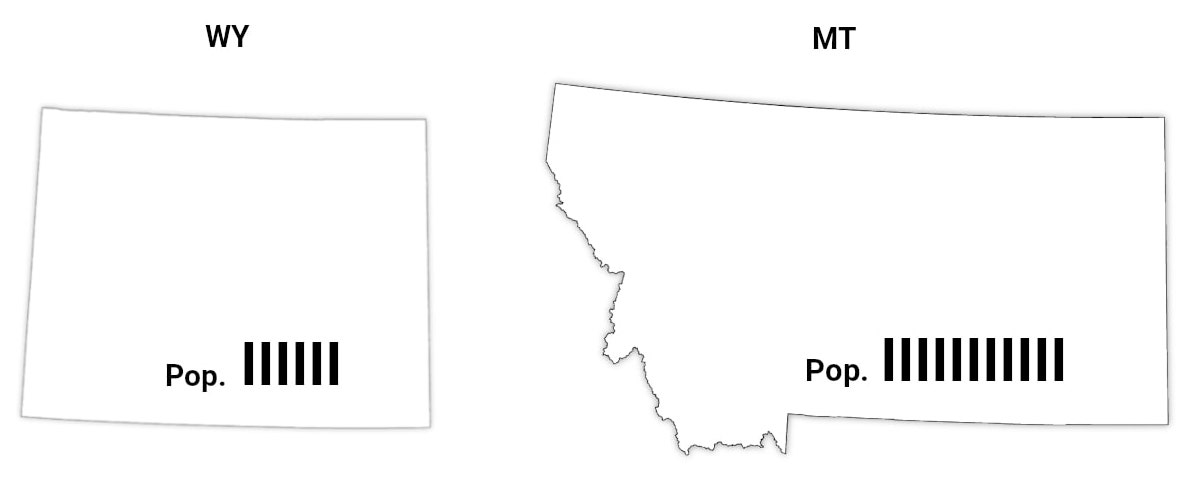
Population
- Montana: 1.1 million
- Wyoming: 577,000
Size
- Montana: 147,040 square miles (380,800 km2)
- Wyoming: 97,914 square miles (253,600 km2)
Wyoming and Montana offer open spaces and spectacular, untouched natural forests, plains, national parks, and wilderness.
Geography – Wyoming vs Montana
Each state’s geography is key to the Wyoming vs Montana debate. Both states are large and sparsely populated, featuring towering mountain ranges, sprawling plains, deep valleys, and diverse ecosystems.
Still, distinct geographical differences may draw you to one state over the other. Let’s have a look in detail.
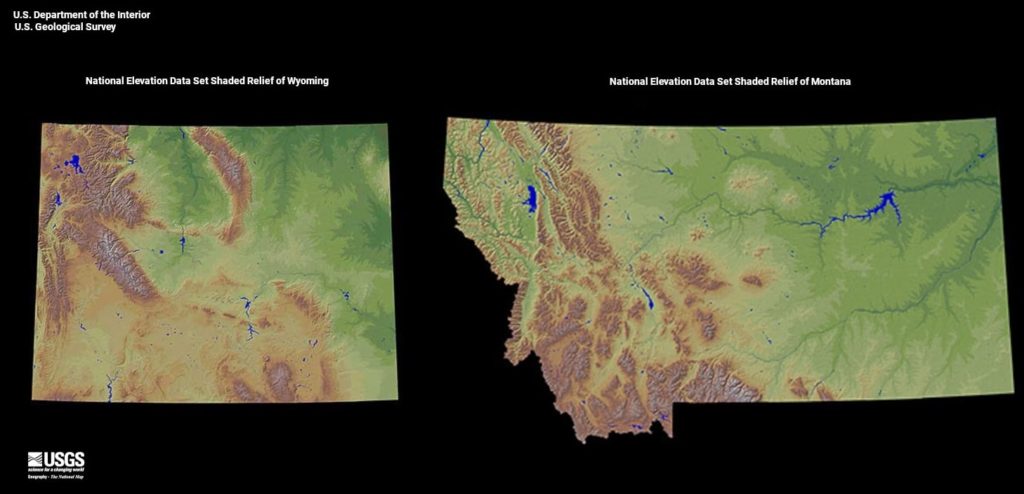
eros.usgs.gov
Montana – Geography
Montana features a diverse range of geological features, ecosystems, and wildlife, including the following:
- Continental Divide. A north-south geographic line that passes through Montana’s Rocky Mountains. All rivers on the west side of the Continental Divide flow west to the Pacific Ocean, while the rivers on its east side flow into the Atlantic Ocean or south to the Gulf of Mexico.
- 100+ mountain ranges. Montana has over 100 sub-mountain ranges, including the Cabinet Mountains and the Gallatin Range. The Absaroka-Beartooth Range is home to Montana’s highest and most stunning peaks.
- 60% prairie. The eastern part of Montana occupies part of the northern Great Plains. This region is home to the Badlands and unique flora and fauna.
- River valleys. Among the 100+ mountain ranges lie alpine lakes and pristine river valleys, such as the Big Hole River, Bitterroot Valley, and Paradise Valley. These rivers and valleys offer agricultural resources and outdoor recreation opportunities.
- Upper Missouri River Breaks. In north-central Montana, the Missouri River flows through a protected area of rolling hills, rock outcroppings, buttes, sparse forests, and wide prairie flats.
- Badlands. Some of the most picturesque regions of the badlands, such as Makoshika State Park and Medicine Rocks State Park, lie in Montana’s eastern region.
- Dinosaur fossils. Many areas in Northeast Montana, such as the Charles M. Russel National Wildlife Refuge and the Hell Creek Plateau, contain dinosaur fossils.
Montana’s wildlife includes a variety of species, including the following:
- Bald eagles
- Grizzly bears
- Mountain lions
- Mountain goats
- Bighorn sheep
- Brown bears
A variety of protected species, such as the Black-footed Ferret and the Whooping Crane, also call Montana home.
Wyoming – Geography
Wyoming is well known for its spectacular mountain ranges, plains, hills, and basins. We list some of Wyoming’s most popular geographic regions below:
- Teton Range. Due to its dramatic beauty, Wyoming’s Teton Range is one of the state’s most well-known mountain ranges.
- Great Plains. The Great Plains meet the Rocky Mountains in Wyoming.
- Plateau. Much of the state is a plateau broken by multiple mountain ranges and valleys, including the summit of Gannett Peak, the tallest peak in Wyoming at 13,804 feet (4,207 m), and the Belle Fourche River valley in the northeast, at 3,125 feet (952 m).
- Black Hills. A unique mountain range in northeast Wyoming, featuring jagged spires of sandstone, granite, limestone, and other rock. Intermixed with lush green forests, it has a dark appearance. The Black Hills have long been sacred to the Lakota Tribe.
- Wind River Range. This mountain range lies in a remote area of west central Wyoming and features 40+ mountain peaks piercing above 13,000 ft (4,000 m).
- Continental Divide. The continental divide splits the middle of the U.S. On its west side, rivers and waterways flow west towards the Pacific Ocean. From its east side, rivers flow into the Atlantic Ocean or south into the Gulf of Mexico.
- Great Divide Basin. The Continental Divide forks in the south-central part of the state forming the Great Divide Basin. Any water that arrives here, including precipitation and river water, cannot escape. It sinks into the soil and evaporates.
- Basins, shrublands, desert, and more. Wyoming features large basins, shrublands, desert, and other eco-regions. Within some of these areas are large geologic formations, sand dunes, and vast unpopulated spaces.
- Lower elevations. Wyoming’s lower elevations feature rolling hills, terraces, valleys, mesas, and rugged terrain with natural springs and rivers interspersed.
- Islands. Wyoming features 32 named islands, most of which are in Jackson Lake and Yellowstone Lake in Yellowstone National Park, as well as the Green River in the southwest.
Wyoming features various wildlife, including the following:
- Bison
- Wolves
- Mountain lions
- Bald eagles
- Grizzly bears
- Wild horses
Endangered species in Wyoming include the grizzly bear, Kendall Warm Springs dace (fish), and the Wyoming Toad.
Wyoming may be overlooked by the buzz of Montana’s tourism, but Wyoming’s natural areas are no less spectacular. They offer a unique flavor of outdoor recreation compared to what you find in Montana.
Verdict: Tie
Cities and towns
A big question in the Wyoming vs Montana debate is, “How do the cities and towns of each state compare?”
Montana and Wyoming have small towns but no large cities. Montana’s largest city, Billings (pop 117,116), is significantly larger than Wyoming’s largest city, Cheyenne (pop 65,123). If you prefer small-town life, then either state will suit you.
Montana cities
Notable cities in Montana include:
- Bozeman. (pop 119,000) A quaint mountain town with a university, large student population, and immediate access to some of the most beautiful areas of Montana, such as the Gallatin Valley. Bozeman is a fast-growing town.
- Missoula. (pop 75,000) A university town in western Montana near Lolo Pass. It has a reputation as a relaxed and fun mountain town.
- Helena. (pop 33,000) The capital of Montana. A small, pleasant town with great access to central Montana’s most beautiful areas, such as the Bob Marshall Wilderness and Canyon Ferry Lake.
Montana also has many quaint towns of about 10,000 people or less, such as Cut Bank, and Dillon, which are worth visiting.
Discover the best places to live in Montana.
Wyoming cities
Wyoming’s cities and towns are generally smaller than most of Montana’s. Notable cities and towns in Wyoming include:
- Cheyenne. (pop 65,123) The capital of Wyoming with a dynamic history and lively atmosphere. Residents of Cheyenne enjoy many restaurants and parks. Cheyenne also offers quick access to the Vedauwoo rock formations and Curt Gowdy State Park.
- Casper. (pop 59,038) A quaint town with quick access to Casper Mountain, Hogadon Ski Area, and the North Platte River. Casper has a unique history: several emigration trails (ex. Oregon Trail, California Trail) intersected here during the westward U.S. expansion in the 1800s.
- Jackson. (pop 10,570) Jackson lies in the 400 square-mile (1,036 km2) Jackson Valley, surrounded by the Gros Ventre Range and Teton Range. Jackson is near Jackson Hole Ski Resort.
The differences between Wyoming and Montana cities and towns are subtle.
Verdict: Tie
Cost of living – Is it cheaper to live in Montana or Wyoming?
The cost of living in Montana and Wyoming is about the same. On average, the cost of living in Montana is only 0.7% greater than Wyoming. However, each state offers drastically different home prices. The average home price in Montana is about 36% higher than in Wyoming.
Housing
Average annual cost of living
Average monthly housing costs
The average price of a home
Utilities
Average monthly utilities costs
Food
Average monthly food costs
Transportation
Average annual transportation costs
Healthcare
Average annual health care costs
Taxes
Highest marginal income tax rate
Income tax rate range
Education
Average undergraduate tuition and fees
| In-state | Out-of-state | |
| Montana | $4,790 | $14,681 |
| Wyoming | $4,628 | $14,005 |
Average graduate tuition and fees
| In-state | Out-of-state | |
| Montana | $7,074 | $22,236 |
| Wyoming | $7,239 | $18,381 |
Detailed breakdown of the cost of living in Wyoming vs Montana
Below, we provide a granular look at living costs in each state.
*Note: This information is based on studies that may or may not represent the true average cost of living in Wyoming or Montana. If you move to either state, you may experience different cost structures. This data serves as a general frame of reference.
Cost of Living in Wyoming
Average annual cost of living: $42,016 per year
Housing
Average monthly housing costs:
$411 to $1,459
The average price of a home in Wyoming is 12% lower than the national average:
- Wyoming: $290,000
- U.S.: $329,542.
Average home prices by city:
- Cheyenne: $326,745
- Casper: $244,090
- Gillette: $277,400
- Rock Springs: $250,928
Median monthly housing costs:
- Mortgage: $1,459
- Studio rent: $411
- One-bedroom rent: $611
- Two-bedroom rent: $800
- Three-bedroom rent: $1,022
- Four-bedroom rent: $1,236
Total housing costs depend on many variables, such as whether you pay a mortgage or rent, the size of your house/apartment, and your city.
Utilities
Average monthly utility costs: $355
Average monthly utility costs, broken down:
- Electricity: $97
- Gas: $83
- Cable/internet: $122
- Water: $53
Food
Average monthly food costs: $324 per person
Transportation
Average annual transportation costs: $4,900 to $13,317
Average annual transportation costs, broken down:
- One adult: $4,900
- Two adults: $8,987
- Two adults, two children: $13,317
Healthcare
Average annual health care costs: $6,894 per person
Total annual healthcare costs vary, depending on individual location and needs.
Taxes
Highest marginal income tax rate: No income tax
Tax rate range: No income tax
Above data: SoFi
Education
Average undergraduate tuition and fees:
- In-state: $4,628
- Out-of-state: $14,005
Average graduate tuition and fees:
- In-state: $7,239
- Out-of-state: $18,381
Education data: College Tuition Compare
Cost of living in Montana
Average annual cost of living: $42,310 per year
Housing
Average monthly housing costs: $590 to $1,429
The average price of a home in Montana is 26% higher than the national average:
- Montana: $394,500
- U.S.: $313,000.
Average home prices by city:
- Billings: $317,514
- Bozeman: $637,164
- Missoula: $509,203
- Helena: $389,041
Median monthly housing costs, broken down:
- Mortgage: $1,429
- Studio rent: $590
- One-bedroom rent: $660
- Two-bedroom rent: $849
- Three-bedroom rent: $1,045
- Four-bedroom rent: $1,211
Total housing costs depend on many variables, such as whether you have a mortgage or rent, the size of your house/apartment, and your city.
Utilities
Average monthly utility costs: $291
Average monthly utility costs, broken down:
- Electricity: $97
- Gas: $52
- Cable/internet: $104
- Water: $38
Food
Average monthly food costs: $318 per person
Transportation
Average annual transportation costs: $4,900 to $13,317
Average annual transportation costs, broken down:
- One adult: $4,900
- Two adults: $8,987
- Two adults, two children: $13,317
Healthcare
Average annual health care costs: $7,560 per person
Total annual healthcare costs vary depending on individual location and needs.
Taxes
Highest marginal income tax rate: 6.9%
Tax rate range: 1% to 6.9%
Montana residents pay graduated income taxes based on their income bracket.
Above data: SoFi
Education
Average undergraduate tuition and fees:
- In-state: $4,790
- Out-of-state: $14,681
Average graduate tuition and fees:
- In-state: $7,074
- Out-of-state: $22,236
Education data: College Tuition Compare
Verdict: Wyoming’s costs are lower in three of the above categories, making it the cheaper state to live in.
Crime – Which state has less crime?
Wyoming has much less crime than Montana.
Here are the violent and property crime rates in Wyoming vs Montana in recent years:
Violent crime in recent years – Wyoming vs Montana
| 2019 | 2020 | 2021 | 2022 | |
| Montana | 405 | 470 | 470 | na |
| Wyoming | 217 | 234 | 241 | na |
| US | 381 | 399 | 396 | na |
Sources:
Montana: 2019 – ucr.fbi; 2020 – Dailymontanan; 2021 – Safewise
Wyoming: 2019 –247WallSt; 2020 –AHR; 2021 – NeighborhoodScout;
U.S.: 2019, 2020 – FBI Crime Data Explorer; 2021 – Statista
Property crime in recent years – Wyoming vs Montana
| 2019 | 2020 | 2021 | 2022 | |
| Montana | 2,193 | 2,182 | 2150 | na |
| Wyoming | 1,571 | na | 1,862 | na |
| US | 2,131 | 2,025 | 1,933 | na |
Sources:
Montana: 2019 – ucr.fbi; 2020 – mbcc.mt.gov; 2021 – Safewise
Wyoming: 2019 –247WallSt; 2021 –NeighborhoodScout
U.S.: 2019, 2020, 2021 – Statista
Below, we compare crime rates in both states over the past four decades.
Violent crime historic trend – Wyoming vs Montana
The graph below shows changes in Wyoming’s violent crime rate since 1980:
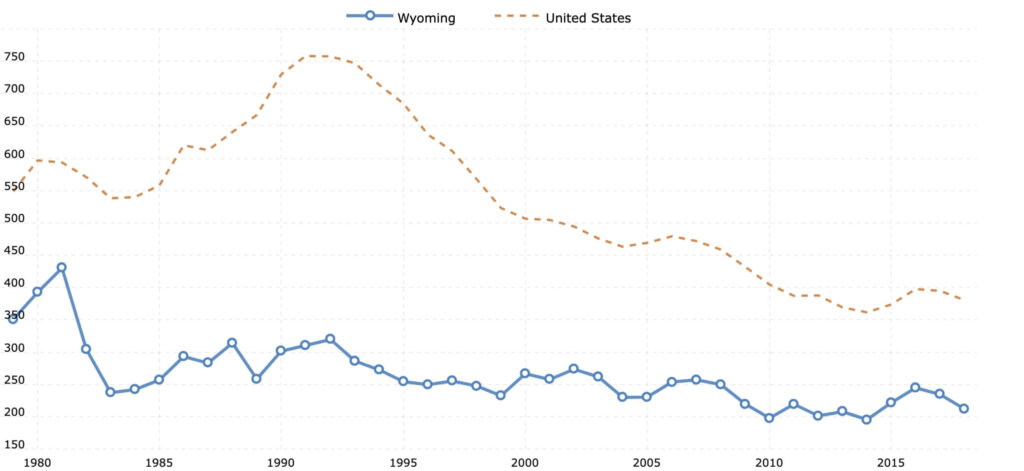
Wyoming’s violent crime rate has remained low and slightly declining, well below the national average, for four decades.
Here’s Montana’s violent crime rate since 1980:
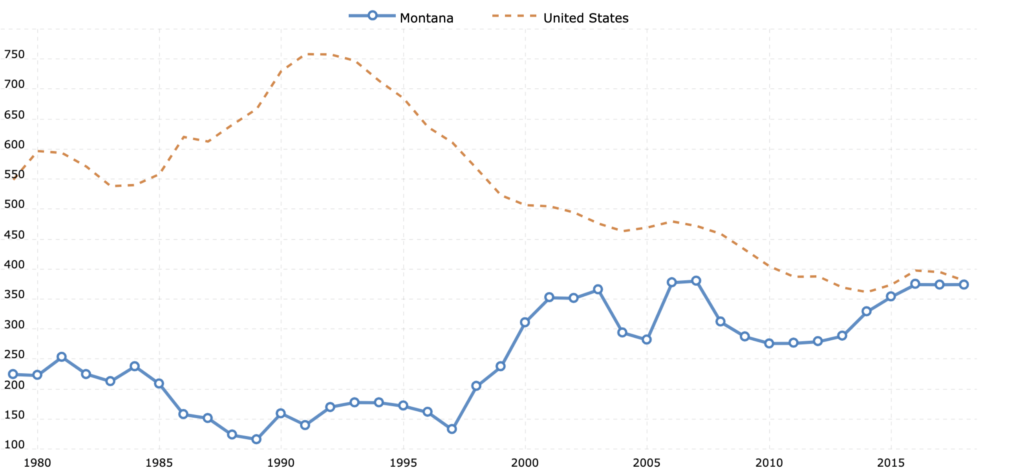
Montana’s violent crime rate has been rising for four decades.
Property crime historic trend – Wyoming vs Montana
The graph below shows changes in Wyoming’s property crime rate since 1980:
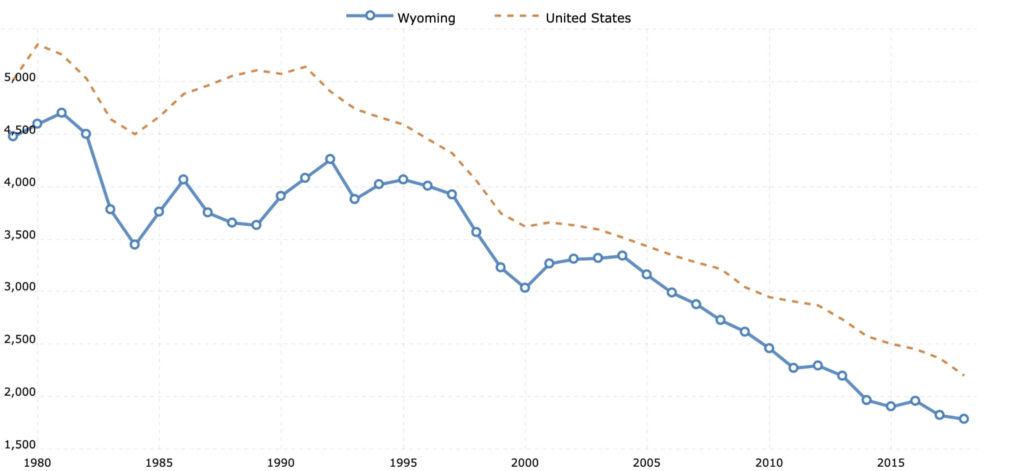
Wyoming’s property crime rate has been steadily falling for four decades and has remained well below the national average.
Here’s Montana’s property crime rate since 1980:
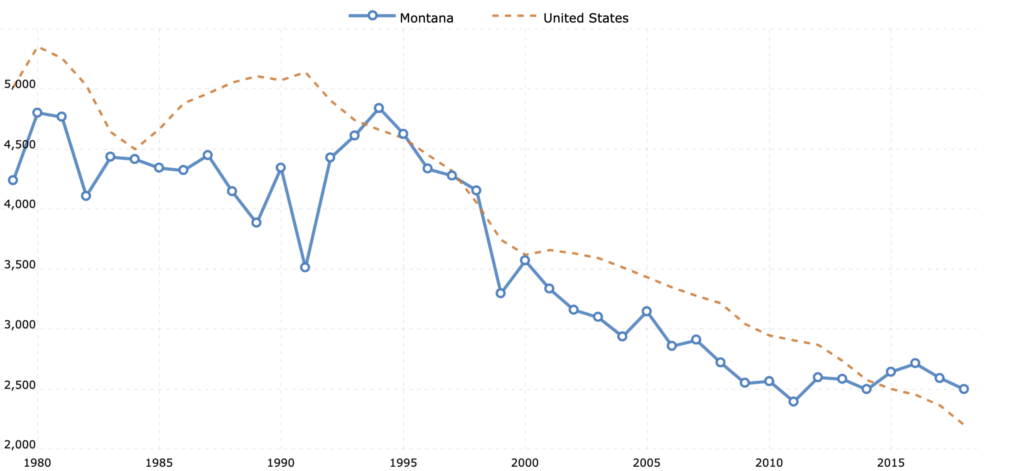
Montana’s property crime rate has also steadily fallen over the past four decades, although it remains much higher than Wyoming’s and the national average.
Verdict
Verdict: Wyoming’s crime rate is much lower than Montana’s.
Consider the following interesting facts about crime in Wyoming:
- Wyoming has the lowest rate of violent crimes of all the mountain states (Montana, Idaho, Utah, Wyoming, Colorado, Nevada, Arizona, New Mexico).
- Wyoming has the third-lowest property crime rate of the mountain states
- Wyoming has lower violent and property crime rates than the national average.
Find out if Montana is a safe place to live in our other article: Is Montana safe?
National parks: Which state has more? Which ones are better?
Montana’s national parks, such as Glacier National Park, often overshadow the national parks of its neighboring states. Nonetheless, Wyoming has seven national parks, each of distinct beauty. Which state has better national parks is a matter of opinion.
We list the top national parks in both states below.
Montana’s national parks
- Yellowstone National Park. A preserved ecosystem of geysers, boiling rivers, geothermal pools, and a variety of wildlife.
- Glacier National Park. A network of towering mountains and glacial-carved valleys. Home of the Going-to-the-Sun Road.
- Nez Perce National Historical Park. Multiple sites of historical and cultural relevance for the Nez Perce Tribe, such as Lolo Trail.
- Grant-Kohrs Ranch National Historic Site. A historic ranch memorializing the icons of the western United States.
- Bighorn Canyon National Recreation Area. A national recreation area with a reservoir crawling between towering cliff sides. It features 120,000 acres of land that has been inhabited by humans for 10,000+ years. It’s also home to diverse wildlife.
- Fort Union Trading Post National Historic Site. One of the most important trading posts in Montana and a bastion of peaceful coexistence for decades throughout the settlement of the western U.S.
- Ice Age Floods National Geologic Trail. Several sites throughout Montana reveal the effects of glacial flooding that ripped across Montana about 18,000 years ago.
- Lewis & Clark National Historic Trail. Several sites along the portion of the Lewis and Clark trail that passed through present-day Montana.
- Upper Missouri River Breaks National Monument. A total of 149 miles of the scenic Missouri River flows through rock outcroppings and rolling hills that have remained preserved for centuries.
Montana’s unique nationally preserved areas are one of the state’s main draws.
Discover all of Montana’s national and state parks.
Wyoming’s national parks
- Yellowstone National Park. A world-renowned national park consisting of geysers, geothermal pools, boiling rivers, and various wildlife. 96% of Yellowstone lies in Wyoming.
- Grand Teton National Park. Grand Teton National Park encompasses the Teton Range and Jackson Hole Valley. Grand Teton National Park lies adjacent to Yellowstone and is a part of the Greater Yellowstone Ecosystem, featuring similar wildlife.
- John D. Rockefeller, Jr. Memorial Parkway. A paved, scenic road connecting Yellowstone National Park and Grand Teton National Park.
- Fossil Butte. A protected area containing fossils from the Eocene Epoch (56 to 34 million years ago) in an area where a lake once covered most of southern Wyoming.
- Bighorn Canyon National Recreation Area. A 120,000-acre (48,562-hectare) area of diverse wildlife straddling the Montana-Wyoming border. Its main draw is the reservoir, which crawls between towering cliff sides.
- Fort Laramie. A key trading post during the United States’ western expansion and one of the most well-preserved forts in the country.
Which state has better national parks depends on personal preferences. Keep in mind the following:
- 96% of Yellowstone National Park lies in Wyoming.
- Wyoming is home to most of Yellowstone and Grand Teton National Parks. Still, Montana is home to epic scenery of Glacier National Park.
- Montana has more national parks, but it’s difficult to say which is more beautiful than the other.
Verdict: Montana wins due to its diversity of parks.
Weather in Montana vs Wyoming
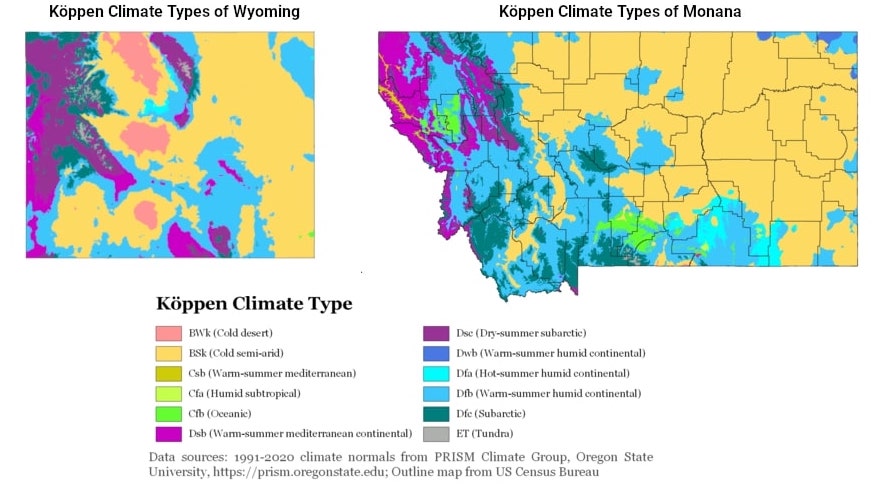
Adam Peterson, CC BY-SA 4.0, via Wikimedia Commons
The weather in Montana and Wyoming is almost the same. For example, both states have the same average annual temperature. Still, there are some key differences. We summarize these in the chart below.
| Montana | Wyoming | |
| Average annual snowfall | More | |
| Average annual sunshine | More | |
| Average annual precipitation | More |
We provide a detailed breakdown of how the weather compares in Montana and Wyoming below.
Average annual temperature
| Montana | 42.7°F (5.9°C) |
| Wyoming | 42°F (5.6°C) |
Average annual sunshine
| % | Total hours | Clear days | |
| Montana | 59% | 2,698 | 82 |
| Wyoming | 68% | 3,073 | 114 |
Average annual snowfall
| Montana | 38.1 in (96.8 cm) |
| Wyoming | 91.4 in (232.2 cm) |
Average annual precipitation
| Montana | 15.3 in (39 cm) |
| Wyoming | 12.9 in (33 cm) |
Both states are colder than about 80% of U.S. states.
Verdict: Wyoming wins because it gets more annual sunshine and snow.
Ski resorts – Which state has better ski resorts?
Montana has a bigger reputation as a skiing destination, but is Montana’s skiing really better than Wyoming’s?
This is a big question in the Wyoming vs Montana debate for many people. Both states feature the Rocky Mountains and are home to incredible ski resorts. Montana has 16 ski resorts, while Wyoming has nine.
The immense and growing popularity of Montana’s Big Sky Resort often draws attention away from surrounding resorts. Still, Wyoming is home to the world-renowned Jackson Hole Ski Resort, which offers excellent skiing in the Teton Range for all levels.
We list the top ski resorts in each state below.
Montana ski resorts
- Big Sky Ski Resort. Big Sky Resort offers some of the biggest skiing in Montana and is one of the most popular ski resorts in the state. Its open spaces and variety of terrain are its main draws.
- Red Lodge Mountain. Red Lodge Mountain is located near Red Lodge, Montana – one of the most quaint and historic towns in the state. This is one of Montana’s funnest resorts, offering great tree skiing, valleys, and gullies.
- Whitefish Mountain Resort. Whitefish Mountain Resort is in the north of the state near Whitefish. The ski resort is famous for its snow ghosts (snow-caked trees resembling columns of snow) and features 3,000 acres (1,214 hectares) of uncrowded terrain.
- Bridger Bowl. Bridger Bowl offers skiing for all levels, including a dynamic ridgeline that is popular among advanced skiers. It’s within an hour’s drive from Bozeman.
Wyoming ski resorts
- Jackson Hole. Some of the best skiing in the U.S. is at Jackson Hole. This resort is especially known for its advanced skiing and excellent access to the backcountry.
- Grand Targhee. A small resort neighboring Jackson Hole. Grand Targhee sits at a slightly higher elevation than Jackson but features similar snow quality. Grand Targhee offers wide open terrain, popular among intermediate and advanced skiers.
- Hogadon Basin. A smaller resort in Casper, Wyoming, with 15 trails serviced by three ski lifts. This resort sees an average of 114 in (4.3 m) of snow each year!
- Meadowlark Ski Lodge. Often called the Jackson of the Bighorn Mountains. This lakeside ski resort is located in north-central Wyoming and offers stunning views of the Bighorn mountains. Thirty-five runs accommodate all skill levels.
When comparing ski resorts in Montana and Wyoming, keep the following in mind:
- Located in one of the most spectacular mountain ranges in the western U.S., Jackson Hole is an attractive resort.
- Montana’s expansive mountain ranges, open space, and towering peaks feature numerous ski resorts to choose from.
Verdict: Tie
Final words: Which is better, Wyoming or Montana?
Is Wyoming or Montana better to live in?
It’s difficult to say which state is better. Montana offers low population density and incredible natural beauty. However, Wyoming offers the same with a slightly lower cost of living and less crime. Ultimately, which state is better depends on personal preferences.
Skip to the comparison chart up top
Wyoming vs Montana – FAQ
Below you can find answers to commonly asked questions about Wyoming and Montana.
Is Wyoming or Montana bigger?
Montana is almost twice as big as Wyoming. Montana contains 147,040 square miles (380,800 km2) of land, while Wyoming contains 97,814 square miles (253,340 km2).
Is Wyoming in Montana?
Wyoming is not in Montana. Wyoming is a separate U.S. state that borders the southern edge of Montana. It also shares a border with Idaho, Utah, Colorado, Nebraska, and South Dakota.
What state is most similar to Wyoming?
The similarity between Wyoming and other states depends on your frame of reference. Wyoming features similar geography to Colorado and Montana. Montana and Wyoming both share similar climates and feature similar agriculture-focused economies. Still, Wyoming is most politically similar to North Dakota.
What’s the difference between Montana and Wyoming?
Montana and Wyoming differ politically. Both states lean to the right. However, there are more liberal areas in Montana than Wyoming. Other differences include crime rates and home prices, both of which are higher in Montana.
What do Montana and Wyoming have in common?
Montana and Wyoming are similar culturally and geographically. Both states lie in the Rocky Mountains and feature sections of the continental divide. Montana and Wyoming run mostly on coal-fired power plants, and agriculture constitutes a major segment of both economies. Politically, both states lean to the right.
When is the best time to visit Montana and Wyoming?
In the summer, both states are warm and offer plenty of summer activities, such as outdoor recreation and eventful city life. However, both states are also popular in the winter due to their beautiful winter scenery and skiing.
Is Montana cheaper than Wyoming?
For vacation, the costs in Montana and Wyoming are about the same. Your vacation costs will largely depend on your accommodation and eating habits. There is a wide cost difference between large resorts and smaller accommodations in both states.
For those considering moving to Montana or Wyoming, the cost of living in both states is about the same. However, housing and healthcare costs are slightly lower in Wyoming.
Is it cheaper to live in Montana or Wyoming?
The cost of living in Wyoming and Montana is about the same. However, housing and healthcare costs are slightly lower in Wyoming.
Does Montana or Wyoming have more people?
Montana has more people than Wyoming. Montana’s population is 1.1 million, while Wyoming’s population is 577,000.
Who has worse winters, Montana or Wyoming?
According to Current Results, the average annual temperature in both states is about the same, at 42°F (5.6°C). However, Montana has set the record for the lowest recorded temperature in the lower 48 states. Wyoming receives about twice as much annual snowfall as Montana, but winters in both states have been relatively mild in recent years.
Is Yellowstone in Montana or Wyoming?
Yellowstone National Park lies in both Montana and Wyoming. However, 96% of the park lies in Wyoming.
Where are Wyoming and Montana?
Wyoming and Montana are mountain states located in the western region of the United States. Montana sits between Idaho and North Dakota on the northern border with Canada. Wyoming borders Montana to the south and is considered a central-western state.
Is Wyoming in Montana?
Wyoming is not in Montana. Wyoming is a U.S. state that borders Montana to the north.
How far is Montana from Wyoming?
Montana borders Wyoming to the south. Depending on your location, the drive between states can be 10+ hours, such as from Missoula to Cheyenne, or just one hour, such as from Cody to Red Lodge.
What state is north of Wyoming?
Montana borders Wyoming to the south.
If Montana is Big Sky Country, what is Wyoming?
The term Big Sky Country refers to Montana. Wyoming’s nicknames include Big Wyoming, the Equality State, and the Cowboy State.
What is a better place to live in – Billings, Montana, or Cheyenne, Wyoming?
Billings is larger than Cheyenne, but both towns offer a quaint, small-town atmosphere. Both have plenty of restaurants and unique parks, and both offer summer events and great access to outdoor recreation.
Billings’ winters are a bit colder and its summers a bit warmer. Both cities have some of the highest crime rates of their respective states, but crime rates in Billings are generally higher than in Cheyenne.


